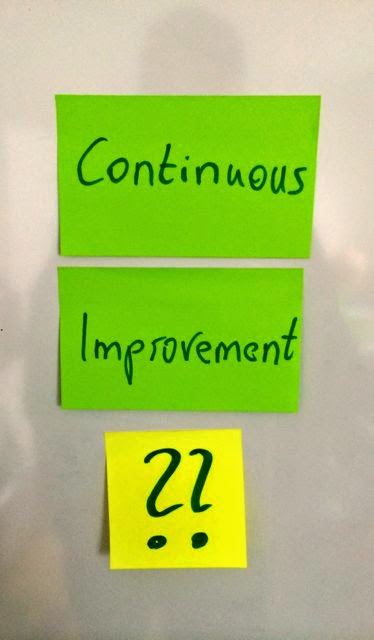I am often asked, “how do you create the right motivation for real organizational change?” Just because you’re using a kanban system does not automatically ensure your company will see all the success it is looking for or that you can make the improvements you seek in productivity. What is the missing ingredient to vast improvements in the fastest manner?
One of the leading success principles begins with creating a culture of continuous improvement. This goes way beyond the constraints of problem solving and ventures into a completely new mindset of permanently solving problems by improving your systems continuously.
With this mindset, there is no longer a beginning and an ending, but rather an evolution and progression of new solutions for new problems and the process continues… forever. However, this change does not come by adding sticky notes to a board. It is a literal shift in thinking that allows more significant system improvements.
But how do we start a culture of continuous improvement? That’s probably the biggest mistake one can do to think “we only have to roll-out our genuine change plan and then we have a culture of continuous improvement in place.” I guarantee: you will fail! Culture is broad, culture is deep. Culture is “how we do it here” and culture is “how we always did it here.” There’s no way that your change plan will change a firmly established culture. The point is
your cultural change already starts with the change process! The Kanban Method supports exactly this idea, which I also discussed in the article
“Signposts towards a culture of continuous improvement.”
Form a Kanban Change Team
If you’re starting with more than a guerrilla Kanban initiative – let’s say at least Flight Level 2 and 30+ internal and external stakeholders – you’ll have to do a little bit of homework. One of the fastest and most effective ways to start is to form a Kanban change team. By building a team, it allows an entire group of people to be responsible for the change. Furthermore, we all know that…
- Groups make better decisions than individuals. We know from experience that the power of groups is far more effective than the single minded purpose of one individual to make good change decisions.
- A team protects an organization from a single point of failure. As an example, what if you had a single person designated as the change agent and she decided to leave your organization? By using a team, you never have to succumb to the limits presented by one person’s issues or concerns.
- Dividing up the work between team members will lead to increased productivity.
- etc.
Building the dynamics of such a diverse team has the potential to affect change more significantly because everyone must come together for this single purpose, yet with differing views and perspectives. How can you use this team to develop its collective power for optimal performance?
Begin by building a diverse change team. Try to win over people from different hierarchies as well as various functions within the organization to be part of the change team. For example, choosing some business individuals along with development people interspersed with project managers and team leaders. The contrasts between functions and hierarchies provide an opportunity to come to joint decision-making that is far superior to stewing in your own juice.
Improve the way you change
In a culture of continuous improvement, an important goal is to improve the way you make improvements. In other words, improve the way you change. A key to making this happen is by conducting a retrospective of past changes.
How can you really improve the future without clearly understanding the past? A retrospective answers two very important questions:
- What went well last time?
- What should we improve this time?
Since the Kanban change team has various levels of experience, expertise and different perspectives, these answers can guide the way for more effective communication and discussion towards problem solving.
Creating an environment of collaboration keeps everyone interested and engaged in the outcome as well as the process. This is also true for change processes! Of course, you still need more than a change team and a retrospective if you want to achieve continuous improvement. The good news is there are three more articles in the queue where I’ll elaborate more about this topic… 😉
